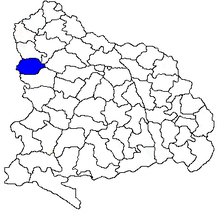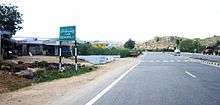Bhoodan Pochampally
| Bhoodan Pochampally భూధాన్ పోచంపల్లి | |
|---|---|
| Census Town | |
.svg.png) Bhoodan Pochampally Location in Telangana, India | |
| Coordinates: 17°23′10″N 78°38′36″E / 17.3861°N 78.6433°ECoordinates: 17°23′10″N 78°38′36″E / 17.3861°N 78.6433°E | |
| Country | India |
| State | Telangana |
| District | Nalgonda |
| Area[1] | |
| • Total | 28.42 km2 (10.97 sq mi) |
| Population (2011)[1] | |
| • Total | 12,972 |
| • Density | 460/km2 (1,200/sq mi) |
| Languages | |
| • Official | Telugu |
| Time zone | IST (UTC+5:30) |
| Postal PIN Code | 508284 |
| Vehicle registration | TS 05 |
Bhoodan Pochampally is a census town in Nalgonda District of the Indian state of Telangana. It is located in Pochampalle mandal of Bhongir division.[1]
Geography
Bhoodan Pochampally is located at 17°23′9.96″N 78°38′35.88″E / 17.3861000°N 78.6433000°E (17.3861, 78.6433),[2]
Demographics
Pochampally is an interesting collage of tradition, history, heritage, modernity and widely known for Pochampally Saree. Surrounded by hills, tanks and ponds, and lush green fields, spread-out silk warps, neera tapping from palm trees, mat-making women, open-sky chatrashala houses, a perennially full tank, hills, temples, Vinoba Mandir - Bhoodan Ashram, and cultural complexes, Pochampally makes up for an exciting destination to spend one’s vacation.
Pochampally sari and industry

Pochampally, a cluster of 80 villages, is the place where threads and colours find their way into the hands of skillful weavers and meander into the market as beautiful sarees and dress material is the most typical weaving village in Nalgonda District of Telangana.
Basking under the glory on par with the weaves of other places (Such as Kanchi, Dharmavaram, Gadwal, Venkatagiri etc.), Pochampally weave is popularly known as ikkat or tie and dye weave. The uniqueness lies in the transfer of design and colouring onto warp and weft threads first and then weave them together. The fabric is cotton, silk and sico - a mix of silk and cotton. Increasingly, the colours themselves are from natural sources and their blends.
Pochampally has traditional looms, whose design is more than a century-old. Today this Silk City is home to more than 10000 weaving families in 100 villages.
History of Pochampally

On 18 April 1951, the historic day of the very genesis of the Bhoodan movement, Vinoba Bhave entered the Pochampally mandal in Nalgonda district, the centre of Communist activity. The organisers had arranged Vinoba's stay at Pochampally, a large village with about 700 families, of whom two-thirds were landless. Pochampally villagers gave Vinoba a warm welcome. By early afternoon villagers began to gather around Vinoba at Vinoba's cottage. The Villagers asked for eighty acres of land, forty wet, forty dry for forty families that would be enough. Then Vinoba asked," If it is not possible to get land from the government, is there not something villagers themselves could do ?" To everyone's surprise, Vedre Ramchandra Reddy a local landlords got up & said in a rather excited voice: "I will give you 100 acres for these people" Ram Chandra Reddy got up & repeated his promise to offer 100 acres of land to the villagers. This incident neither planned nor imagined was the very genesis of the Bhoodan movement & it made Vinoba think that there in lay the potentiality of solving the land problem of India. This movement later on developed into a village gift or Gramdan movement. As the huge, massive and magnificent movement called Bhoodan Movement was born at this village Pochampally, the village renamed to Bhoodan Pochampally.
In 1999, the weaving industry of Bhoodan Pochampally came to limelight when a young weaver C Mallesham developed a machine for automating the time consuming, laborious and painful Asu process of winding of yarn before the dyeing and weaving is done. The innovation was recognized by National Innovation Foundation – India.[3] then by A.Srikanth

See Also
References
- 1 2 3 "District Census Handbook - Nalgonda" (PDF). Census of India. p. 13,248. Retrieved 11 February 2016.
- ↑ "US Gazetteer files: 2010, 2000, and 1990". United States Census Bureau. 2011-02-12. Retrieved 2011-04-23.
- ↑ Recognition of Asu Machine by National Innovation Foundation
External links
| ||||||||||||||||||||||